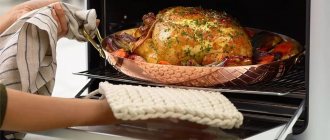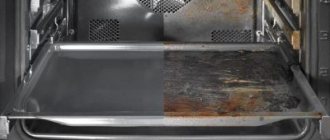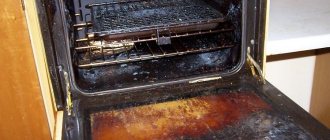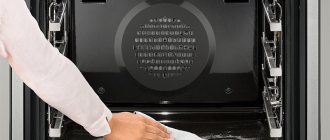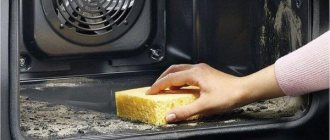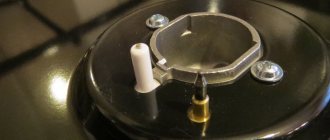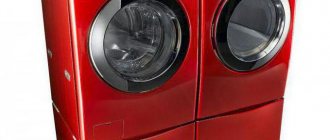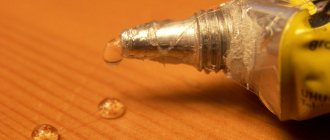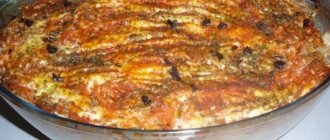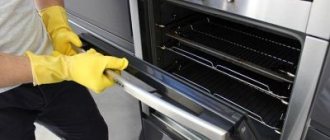Oven steam cleaning is a method of getting rid of grease and other contaminants inside the oven. For many women, cleaning the oven at home is an unpleasant procedure. Contaminants accumulate on the inner surface during the cooking process, so for those who cook frequently, this problem cannot be avoided. In order for your household appliance to last longer and maintain its ideal appearance, you need to clean it periodically.
Pros and cons of hydrolysis
Steam cleaning cannot be called a completely automatic removal of contaminants in the oven. But this treatment greatly simplifies the process of caring for the stove. Hydrolysis has its advantages and disadvantages compared to other methods
Pros:
hydrolysis will not require the cost of expensive household chemicals;- since cleaning occurs at relatively low temperatures, energy consumption is low;
- steam cleaning helps save time; After the procedure, all that remains is to remove the softened stains with a rag - this is much more convenient than scrubbing dried stains with force for a long time;
- the hydrolysis process is safe - since the exposure temperature is low, the cabinet door does not overheat and the risk of getting burned is minimal.
Minuses:
- after the procedure is completed, dirt may remain on the cabinet walls that will have to be removed manually;
- to remove stubborn stains, the cleaning procedure will have to be repeated or removed manually - for this reason, it is recommended to carry out the process of treating the oven with steam in a timely manner;
- hydrolysis can only be carried out after the oven has completely cooled; You should not organize such cleaning immediately after finishing cooking.
Which cleaning method to choose
Each method of cleaning the inside of the oven has its own disadvantages and advantages. There are three methods of cleaning the oven - steam, pyrolysis and catalytic method:
- Catalytic cleaning is found in electrical and gas cabinets. With this method, contaminants are removed during the cooking process, so there is no need to incur additional energy costs. This method of cleaning the inner surface does not require human presence. After a certain period of use, catalytic panels become unusable and need to be replaced. Ovens with a similar function are expensive, so not everyone can afford such household appliances. Self-cleaning enamel does not cover all surfaces of the cabinet walls, so some individual elements will have to be washed by hand.
- Hydrolysis treatment occurs at low temperatures. To carry out such cleaning, no monetary costs are required. In addition, the method involves minimal energy consumption. But this method has a significant disadvantage, which is that hydrolysis does not get rid of all contaminants. Cleaning is an auxiliary method before washing the cabinet. If particles of food and other contaminants on the inner wall of the oven have not dried, but are in a damp state, then cleaning the inner surface of the cabinet will be very effective.
- Pyrolytic cleaning does not require much time. This method has a disadvantage: you have to occupy a baking sheet. This method of cleaning contaminated surfaces is the most effective. The oven uses special high-quality materials that can withstand high temperatures. But cabinets with this function are much more expensive than other models. During the pyrolysis process, an unpleasant burning odor may appear. On some oven models, the side walls may become very hot during the process.
Each cleaning method has its own pros and cons. Cleaning a cabinet with steam is an affordable method for all housewives. Moreover, it is the least expensive.
How to clean surfaces?
There are 2 ways to steam clean an oven. In the first case, improvised means are used for processing, for example, a baking sheet or other container. Ovens with a built-in hydrolysis function will not require additional reservoirs.
Built-in function
Ovens equipped with the Aqua Clean program are equipped with a special tank. Water is poured into it with the addition of detergents with a non-aggressive composition. During the hydrolysis process, fat drains from the walls along with dirt and ends up in a special tray for collecting dirt.
How to steam clean your oven using the built-in Aqua Clean function:
Remove kitchen utensils from the oven.- Pour water into a special reservoir at the bottom of the oven (the exact volume of liquid required is indicated in the instructions for the oven).
- Close the door.
- Start the steam cleaning function.
- When the oven beeps to indicate the end of the cycle, you need to turn off the oven and open the door.
- Use a soft cloth to wipe away any remaining moisture and wipe the walls inside the oven, simultaneously removing softened dirt.
- Wipe the surface of the oven with a dry cloth.
- Leave the oven open for 30 minutes until the interior of the cabinet is completely dry.
Manual method
If your oven does not have a built-in steam cleaning function, you can prepare a cleaning solution yourself:
- pour a small amount of water into a baking tray;
- pour in water or pour out detergent or cleaning agent;
- set the oven temperature to 100 C°;
- place a baking sheet with water and cleaning agent inside the oven;
- close the door;
- turn off the oven after 40 minutes.
Under the influence of temperature, water begins to evaporate. In combination with detergent, it acts on dirt that has settled on the walls. As a result, the plaque softens and can be easily removed with a soft cloth.
Before the hydrolysis procedure, stubborn dirt can be wiped with a concentrated solution of citric acid or lemon slices.
Oven cleaning: which one is better?
All types of oven cleaning are good in their own way. However, you need to choose the one that will meet all your requirements. If, for example, you do not use the oven often, then hydrolysis or catalytic cleaning is suitable for you. And if regularly, then only pyrolytic. But for those who want to save money, by the way, there will also be an oven with the traditional method.
Oven cleaning, which is better? Many people cannot decide for themselves which cleaning method to choose an oven with. Therefore, they doubt their choice for a long time. To do this, you just need to carefully weigh all the pros and cons of the device you choose.
Many people ask: advise the best model from many options. It is best to choose a device with catalytic cleaning. It is more economical and is also suitable for both electric and gas appliances.
All types of cleaning:
- Traditional;
- Catalytic;
- Hydrolytic;
- Pyrolytic.
You can also find ovens with a type of cleaning called ecolysis. This is one of the types of catalytic cleaning, however, it provides greater environmental friendliness. Manufacturers such as Bosch and Siemens produce just such ovens. The Ariston company produces only 7 types of ovens with catalytic cleaning and 8 with pyrolytic cleaning, all of them have a high price. Other models have traditional cleaning.
Comparison with other methods
In addition to hydrolytic cleaning of ovens, there are also pyrolytic and catalytic cleaning. Each type of processing has its own characteristics:
| Hydrolytic | Catalytic | Pyrolytic | |
| Cleaning Features | Dirt softens under the influence of steam | Fats are broken down under the influence of catalysts located in the oven walls | Dirt and grease are reduced to ash by high temperatures |
| Temperature | 90-100 C° | 140-250 C° | Up to 500 C° |
| Frequency of application | Several times a month, depending on how often you use the oven | After every meal preparation | As needed |
| Electricity consumption | Small | Average | High |
| Consumables | Water | Catalytic panels | No |
| The need to use household chemicals at the final stage of cleaning | Required | Required | Not required |
| Oven cost | Low | Average | High |
| Efficiency | Softens dirt | Effective for removing fresh stains | Removes both fresh and stubborn dirt |
The choice of a specific type of oven cleaning depends on the wishes of the buyer. When choosing, you should take into account the economic side of the issue: the cost of the oven and energy costs, as well as processing time.
Effective pyrolytic cleaning: its advantages
The most effective type of cleaning is pyrolytic. This system is the newest and, accordingly, such devices cost quite a lot. This pyrolysis cleaning is based on the combustion of contaminants at high temperatures. Pyrolysis is a very complex thermal decomposition of various compounds. Pyrolytic means splitting.
Pyrolytic cleaning occurs at a very high temperature, which ranges from 250 to 500 degrees. At this temperature, all contaminants burn to form ash. This is a home crematorium.
If previous types of cleaning include partial manual assistance, then pyrolytic cleaning does everything itself, freeing the owner from additional cleaning. Since combustion occurs at very high temperatures, the oven door locks itself. Therefore, it can be opened only after the process is completed.
Useful tips
To make hydrolytic oven cleaning more effective, it is useful to consider several recommendations:
- In addition to dishwashing detergent, you can add other cleaning agents to the water poured into the pan: citric acid, vinegar, orange or lemon juice.
- Steam cleaning can be repeated to remove stubborn stains.
- Used water should not be left in a baking tray or special oven compartment overnight.
Modern technology: oven cleaning systems (video)
When choosing an oven, do not forget to pay attention to its cleaning type. Some types of models may not be suitable for you due to their low functionality and cleaning method. However, following the reviews, we can conclude that the model with catalytic purification is in greater demand than other systems (hydrolysis, traditional and pyrolytic).
Burn it down
In contrast to delicate low-temperature cleaning modes, pyrolysis is the breakdown of fat particles at high temperatures (about 500°C). In this mode, the oven door automatically locks as soon as the internal temperature reaches 300°C to prevent children from opening it suddenly. The door can only be opened again after the temperature inside has dropped to 200°C. After the pyrolysis is completed, the housewife can only sweep the ashes out of the oven.
The vapors generated in the oven at such high heat are purified when passing through a special filter, so that no unpleasant odors are formed in the kitchen. And yet, sometimes you can hear the opinion that pyrolysis is accompanied by a characteristic odor. It's all about the accuracy of the stove owner. A pyrolytic cleaning system can work wonders, but its possibilities are limited. If you clean the oven only once every six months, odors cannot be avoided. Experts recommend pyrolytic cleaning after every serious cooking. Then no odors will form, and the stove will be in perfect order.
The result of pyrolysis is impressive: in Fig. 5 mounted views of the internal cavity of the oven before and after pyrolysis. As they say, feel the difference!
Rice. 5. View of the internal cavity of the oven before pyrolytic cleaning (left) and after it (right)
Depending on the degree of contamination of the oven, the owner can set the light, medium or intensive cleaning mode (Fig. 6). Until recently, this was the only “degree of freedom” when operating such an oven. Recently, manufacturers of household appliances have offered owners of their products new opportunities.
Rice. 6. Change in temperature in the oven cavity depending on the specified pyrolytic cleaning mode
Do you know how often housewives use the oven? Special studies have shown that, for example, in Moscow - from 2 to 4 times a week. And English housewives do this 7-10 times a week, but they cook mostly not meat dishes, but vegetables, for example, such unimaginable dishes for you and me as baked cucumbers. To remove light, “vegetable” contaminants from the oven, a comfortable pyrolysis mode was invented, which included a pre-firing phase of the oven cavity (Fig. 7). It is used in Gaggenau brand products and other BSH products. Pre-firing takes place at a low temperature, and, therefore, energy costs for the entire cleaning cycle are reduced.
Rice. 7. Comfortable pyrolysis mode (BSH ovens)
The next stage in the evolution of pyrolysis is associated with the introduction of an additional element into the oven design - a catalytic filter with a small heating element of its own. Residues of food burn out on the filter, so its temperature is slightly higher than the temperature in the oven (Fig. 8). When these residues burn out and the temperature of the filter is equal to the temperature in the cavity, pyrolysis can be completed. Indeed, why waste electricity?
Rice. 8. Automatic pyrolysis mode
The problem of automatically monitoring the residual level of contaminants in Whirlpool pyrolytic ovens has been solved differently. Here, a special sensor of the “6th sense” system monitors the concentration of carbon dioxide in the cavity. There is a lot of gas, which means that the pollution is still decomposing under the influence of high temperature. The concentration of carbon dioxide began to fall, which means that all fatty contaminants have already disintegrated. The sequence of steps for such pyrolytic cleaning is shown in Fig. 9.
a) during cooking, fat particles are formed and deposited on the walls of the oven
b) the process of pyrolytic cleaning is in progress
c) during the pyrolytic decomposition of contaminants, carbon dioxide is formed
d) the sensor of the “6th sense” system analyzes the concentration of carbon dioxide
e) the decomposition of contaminants is complete - the remaining gas is removed by a fan
e) all that remains is to wipe the oven - it’s cleaned
Rice. 9. Pyrolytic oven cleaning with the “6th sense” system (Whirlpool)
Comparative technical characteristics of the hydrolysis method
This method has been used for quite a long time, which allows us to give an objective description of its strengths and weaknesses.
Advantages of the hydrolysis method
The versatility of the method. This is a very important advantage; it makes it possible to use it for absolutely all ovens with the same efficiency, regardless of their type, material of manufacture and available additional functions. During cleaning, heating to only approximately +100°C is required. For example, pyrolytic cleaning occurs at a temperature of +500°C; not all materials used for the production of ovens can withstand it.
As for the catalytic method, only special finishing surfaces of internal elements are cleaned this way.
The hydrolysis method makes it possible to clean all internal elements at the same time. Stainless steel racks, baking sheets, and baking dishes are loaded into the oven. The steam is equally successful in softening fatty deposits from all surfaces.
Minimum cost. The cost of cleaning tends to zero; only traditional methods will be cheaper. The catalytic cleaning method is considered very economical; it is performed simultaneously with cooking, while for the hydrolysis method it is necessary to turn on the oven separately. But this is not entirely true for several reasons. Firstly, during any cooking, steam is released, which means that it softens fat deposits, making surfaces much easier to clean immediately after cooling. Secondly, the internal surfaces only need to be heated for 30 minutes, and coolant losses are minimal. Thirdly, the cost of special catalytic coatings can be considered the price of its cleaning; nothing is done for free in our time.
Safety. This method does not damage important elements of the oven, and injuries are minimized. The only limitation is not to use products containing aggressive chemical compounds. This can cause corrosion of metal surfaces and allergic reactions.
As you can see, the method has quite a lot of advantages, but, unfortunately, there are also disadvantages.
Flaws
There are only a few of them, they are present in most existing cleaning methods.
- Presence of a strong unpleasant odor. Appears only when special detergents are used for cleaning. To eliminate odor, it is recommended to use deodorants and turn on the hood at maximum output. You need to know that the most modern pyrolytic method produces the most unpleasant odors; under certain conditions, the entire kitchen room can be filled with smoke. Do not use homemade detergents, do not experiment with unknown compositions, and the likelihood of odors will decrease dramatically.
- Duration of the process. Cleaning time depends on several components: the degree of contamination, the chemical characteristics of the liquids used, skill and diligence.
Hydrolysis cleaning is ineffective when it is necessary to remove old or difficult stains
There are cases of mechanical damage to surfaces, but they only appear due to violations of recommendations: metal brushes or acid are used for cleaning, attempts are made to cut off small deposits with sharp objects, etc.
Effective pyrolytic cleaning: its advantages
The most effective type of cleaning is pyrolytic. This system is the newest and, accordingly, such devices cost quite a lot. This pyrolysis cleaning is based on the combustion of contaminants at high temperatures. Pyrolysis is a very complex thermal decomposition of various compounds. Pyrolytic means splitting.
Pyrolytic cleaning occurs at a very high temperature, which ranges from 250 to 500 degrees. At this temperature, all contaminants burn to form ash. This is a home crematorium.
If previous types of cleaning include partial manual assistance, then pyrolytic cleaning does everything itself, freeing the owner from additional cleaning. Since combustion occurs at very high temperatures, the oven door locks itself. Therefore, it can be opened only after the process is completed.
Advantages of this cleaning system:
- The most effective method;
- Does not require additional manual work;
- Able to cope with the most complex and long-standing contaminants;
- Performs complete cleaning;
- Turns varying degrees of pollution into ash.
Such devices are made only from very durable and high-quality materials. This method is used only for electric ovens. A huge disadvantage of such ovens is that the outer walls have the ability to get very hot. Therefore, such devices are not quite safe. Great care is required to avoid getting burned. In addition, the wiring may not withstand it if it is weak. Of course, the reviews for such cleaning are the highest, since it is the most practical system.
Modern technology: oven cleaning systems (video)
When choosing an oven, do not forget to pay attention to its cleaning type. Some types of models may not be suitable for you due to their low functionality and cleaning method. However, following the reviews, we can conclude that the model with catalytic purification is in greater demand than other systems (hydrolysis, traditional and pyrolytic).
Modern household appliances have options that eliminate many kitchen hassles. One of these is automatic oven cleaning.
.
This function eliminates the need to climb into the chamber and scrape off the fat that has frozen on the walls. Automatic cleaning
not only saves you from a time-consuming and unpleasant process, but also helps you properly maintain the device. Thanks to her, the equipment lasts a long time.
How to steam clean without hydrolysis technology
If the oven is not equipped with a hydrolysis function, you can still clean it with steam. You need to take a heat-resistant container or a baking sheet with high sides and pour at least 0.5 liters of water into it. Place on the lower level of the oven or at the very bottom. Turn on the oven, setting the temperature to 100-150 degrees. If there are persistent stains on the surface, it is recommended to add 50-100 ml of dishwashing liquid to the water. As soon as the water boils, dirt on the walls will begin to soften under the influence of the resulting steam. After the liquid has boiled away, turn off the oven and open the door slightly. When the walls become warm, remove the dirt manually. It is not recommended to use abrasive powders, hard brushes and sponges, as they can damage the coating.
About strengths and weaknesses
Such cleaning will affect the cost - such ovens are more expensive, because high thermal insulation must be maintained, and all elements must be made of heat-resistant materials.
Strengths cannot be offset by weaknesses. There is no need to buy detergents, and skin contact with chemicals is minimized. The cleaning of the internal parts will be of high quality; this effect cannot be achieved manually. So, the positive points:
- the most effective cleaning;
- easy removal of residual fat, milk, syrups, and other stuck products;
- there is no need to buy detergents, change filters and other elements.
Among the disadvantages it is worth highlighting:
- increased cost of stoves;
- consumption of large amounts of electrical energy;
- the occurrence of unpleasant odors due to poor exhaust hoods and very strong accumulations of dirt.
Pyrolysis cleaning is not complicated. Remove everything from the oven, including baking sheets and wire racks. They are washed by hand. The cleaning mode is then started, during which the door is locked for safety. After completing the procedure, wipe the internal parts with a soft cloth to remove soot.
The recommended frequency of cleaning is once every 30 days. Duration 1 hour-2.5 hours. A significant part is taken up by cooling. Some built-in models have special tubes that connect directly to the vent. To prevent odors from becoming too strong, ovens must be cleaned regularly.
Oven cleaning: which one is better?
All types of oven cleaning are good in their own way. However, you need to choose the one that will meet all your requirements. If, for example, you do not use the oven often, then hydrolysis or catalytic cleaning is suitable for you. And if regularly, then only pyrolytic. But for those who want to save money, by the way, there will also be an oven with the traditional method.
Oven cleaning, which is better? Many people cannot decide for themselves which cleaning method to choose an oven with. Therefore, they doubt their choice for a long time. To do this, you just need to carefully weigh all the pros and cons of the device you choose.
Many people ask: advise the best model from many options. It is best to choose a device with catalytic cleaning. It is more economical and is also suitable for both electric and gas appliances.
All types of cleaning:
- Traditional;
- Catalytic;
- Hydrolytic;
- Pyrolytic.
You can also find ovens with a type of cleaning called ecolysis. This is one of the types of catalytic cleaning, however, it provides greater environmental friendliness. Manufacturers such as Bosch and Siemens produce just such ovens. The Ariston company produces only 7 types of ovens with catalytic cleaning and 8 with pyrolytic cleaning, all of them have a high price. Other models have traditional cleaning.
Pyrolysis, hydrolysis or catalysis – which is better?
Oven Cleaning Type Comparison Chart
Each type of cleaning has its own advantages and disadvantages.
When making a choice in favor of one technology or another, you should consider:
- how often the device will be used;
- what price segment is acceptable;
- what should be the quality of the materials used;
- Is it important to fully automate the process or is minor manual cleaning allowed?
- what is the power of the electrical wiring;
- Do you have a powerful hood at home?
The pyrolysis model is convenient if it is possible to purchase expensive equipment, a wire with a power of at least 600 W is installed, and the kitchen is equipped with a powerful hood.
Hydrolysis does not require large amounts of electricity, eliminating the possibility of burns. The method is quite simple and cost-effective, but requires additional manual work to remove any remaining burnt fat.
If saving money is a priority, then the best option would be a gas stove with a catalytic type of removal of old contaminants, although this type of equipment is less functional than electric ovens. Catalysis is suitable for frequent use of the stove and will greatly facilitate the process of removing old grease and stains.
Additional Solutions
The easiest way to clean the oven is to use specialized products sold in stores. Typically, such detergents are inexpensive, and one bottle lasts a long time. When using this method, you need to remember that before using the product you should moisten all surfaces with water. But such drugs are characterized by an aggressive effect, and therefore can damage the enamel on the walls of the cabinet.
Stores sell special devices that have self-cleaning enamel. Fat deposits almost do not stick to it. If something burns, you can easily get rid of such contaminants. This effect can be explained by the presence of catalyst particles in the enamel structure. The compound decomposes any fats. This method is called catalytic. It involves the use of low temperatures. To increase the efficiency of the catalytic cleaning method, install an additional grease filter.
Another method of cleaning the device is pyrolysis . It is based on the complete combustion of fat and food particles. This is the most aggressive method of combating pollution of all those described. Ashes remain in the oven chamber after use. In this case, the door to the oven is blocked and there is no way to open it yourself.
Pyrolysis puts a strain on the device, and therefore cannot be called gentle. It is available in selected Bosch and Gaggenau models.
Food particles can be burned at lower temperatures, so a level system of operation is provided here. This allows you to further save electricity.
Housewives reviews
I have never tried steam cleaning an oven. My neighbor told me in detail what it is. Before this conversation, I used standard measures and spent a lot of time and effort cleaning centimeter by centimeter by hand. There is no need to spend money on buying detergent. The whole process takes no more than 15 minutes, because most of the fat is gone, and its remnants can be quickly removed by hand.
Elena, St. Petersburg
I love this method because it really saves time. Some people claim that it is impossible to get rid of all contaminants using the steam method. I don’t agree with this, because thanks to this method my oven is always clean. To ensure that no traces of dirt remain, you just need to wash the walls of the device more often. If you do this not after every meal preparation, but put it off until later, then, of course, you will have to spend a lot more time scrubbing.
Kristina, Voronezh
My daughter told me about this unique method. I used to spend a lot of detergent cleaning the oven and really didn't like it. It took a lot of time; by the time you clear all the fat, you get pretty tired. Now sometimes I also use detergent components, but much less of them is required due to steam treatment. It softens all the grease, so just drop a little stove cleaner onto a sponge and rub it along the walls. Not a trace of dirt remains, but you need to do this before the surface of the oven has cooled down.
Elena, Belgorod
How good are pyrolysis ovens?
If we compare them with cars, then these are premium Mercedes
. And we’re not just talking about the high cost of ovens with pyrolytic cleaning.
In order for them to function at full capacity, their quality must be very high, which means their service life is quite long.
The steel used for them is of the highest quality, which is not afraid of high temperatures of prolonged exposure. The interior of the oven is covered with heat-resistant enamel, and all components are high-tech items.
For example, an Electrolux oven with pyrolytic cleaning has 4 heat-resistant glasses that can easily withstand such a temperature load. Additionally, they are equipped with cooling systems for external surfaces.
Important! The procedure must be carried out in the absence of children and pets in the room. Safety of use is ensured by:
Safety of use is ensured by:
- automatic door locking systems;
- highly sensitive temperature and carbon monoxide sensors;
- a system that prevents the combustion of fatty deposits in the combustion chamber;
- grease absorption filters on the convector grille.
Modern appliances have a presentable and expensive appearance, which makes them a decoration for any kitchen.
And it doesn’t matter if it’s the kitchen of an expensive restaurant or homemade
